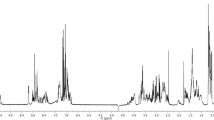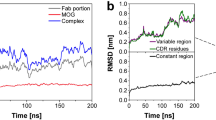Abstract
Τwo dimensional nuclear magnetic resonance studies complimented by molecular dynamics simulations were conducted to investigate the conformation of the immunodominant epitope of acetylated myelin basic protein residues 1–11 (Ac-MBP1–11) and its altered peptide ligands, mutated at position 4 to an alanine (Ac-MBP1–11[4A]) or a tyrosine residue (Ac-MBP1–11[4Y]). Conformational analysis of the three analogues indicated that they adopt an extended conformation in DMSO solution as no long distance NOE connectivities were observed and seem to have a similar conformation when bound to the active site of the major histocompatibility complex (MHC II). The interaction of each peptide with MHC class II I–Au was further investigated in order to explore the molecular mechanism of experimental autoimmune encephalomyelitis induction/inhibition in mice. The present findings indicate that the Gln3 residue, which serves as a T-cell receptor (TCR) contact site in the TCR/peptide/I–Au complex, has a different orientation in the mutated analogues especially in the Ac-MBP1–11[4A] peptide. In particular the side chain of Gln3 is not solvent exposed as for the native Ac-MBP1–11 and it is not available for interaction with the TCR.








Similar content being viewed by others
References
Steinman L (1996) Multiple sclerosis: a coordinated immunological attack against myelin in the central nervous system. Cell 85:299–302
Martin R, McFarland H, McFarlin D (1992) Immunological aspects of demyelinating diseases. Annu Rev Immunol 10:153–187
Hemmer B, Archelos JJ, Hartung HP (2002) New concepts in the immunopathogenesis of multiple sclerosis. Nat Rev Neurosci 3:291–301
Hafler DA, Slavik JM, Anderson DE, O’Connor KC, De Jager P, Baecher-Allan C (2005) Multiple sclerosis. Immunol Rev 204:208–231
Zamvil SS, Steinman L (1990) The T lymphocyte in experimental allergic encephalomyelitis. Ann Rev Immunol 8:579–621
Zamvil SS, Mitchell DJ, Moore AC, Schwarz AJ, Stiefel W, Nelson PA, Rothbard JB, Steinman L (1987) T-cell specificity for class II(I–A) and the encephalitogenic N-terminal epitope of the autoantigen myelin basic protein. J Immunol 139:1075–1079
Zamvil SS, Mitchell DJ, Moore AC, Kitamura K, Steinman L, Rothbard JB (1986) T-cell epitope of the autoantigen myelin basic protein that induces encephalomyelitis. Nature 324:258–260
Gautam AM, Pearson CI, Smilek DE, Steinman L, McDevitt HO (1992) A polyalanine peptide with only five native myelin basic protein residues induces autoimmune encephalomyelitis. J Exp Med 176:605–609
Wraith DC, Smilek DE, Mitchell DJ, Steinman L, McDevitt HO (1989) Antigen recognition in autoimmune encephalomyelitis and the potential for peptide-mediated immunotherapy. Cell 59:247–255
Anderton SM, Radu CG, Lowrey PA, Ward ES, Wraith DC (2001) Negative selection during the peripheral immune response to antigen. J Exp Med 193:1–11
Lee C, Liang MN, Tate KM, Rabinowitz JD, Beeson C, Jones PP, McConnell HM (1998) Evidence that the autoimmune antigen myelin basic protein (MBP) Ac1–9 binds towards one end of the major histocompatibility complex (MHC) cleft. J Exp Med 187:1505–1516
He XL, Radu C, Sidney J, Sette A, Ward ES, Garcia KC (2002) Structural snapshot of aberrant antigen presentation linked to autoimmunity: the immunodominant epitope of MBP complexed with I–Au. Immunity 17:83–94
Fugger L, Liang J, Gautam A, Rothbard JB, McDevitt HO (1996) Quantitative analysis of peptides from myelin basic protein binding to the MHC class II protein, I-Au, which confers susceptibility to experimental allergic encephalomyelitis. Mol Med 2:181–188
Metzler B, Wraith DC (1993) Inhibition of experimental autoimmune encephalomyelitis by inhalation but not oral administration of the encephalitogenic peptide: influence of MHC binding affinity. Int Immunol 5:1159–1165
Mason K, Denney DW, McConnell HM (1995) Myelin basic protein peptide complexes with the class II MHC molecules I–Au and I–Ak form and dissociate rapidly at neutral pH. J Immunol 154:5216–5227
Fairchild PJ, Wildgoose R, Atherton E, Webb S, Wraith DC (1993) An autoantigenic T cell epitope forms unstable complexes with class II MHC: a novel route for escape from tolerance induction. Intern Immunol 5:1151–1158
Goverman J, Woods A, Larson L, Weiner LP, Hood L, Zaller DM (1993) Transgenic mice that express a myelin basic protein-specific T cell receptor develop spontaneous autoimmunity. Cell 72:551–560
Maynard J, Petersson K, Wilson DH, Adams EJ, Blondelle SE, Boulanger MJ, Wilson DB, Garcia KC (2005) Structure of an autoimmune T cell receptor complexed with class II peptide-MHC: insights into MHC bias and antigen specificity. Immunity 22:81–92
Morikis D, Roy M, Sahu A, Troganis A, Jennings PA, Tsokos GC, Lambris JD (2002) The structural basis of compstatin activity examined by structure-function-based design of peptide analogs and NMR. J Biol Chem 277:14942–14953
Mantzourani ED, Blokar K, Tselios TV, Matsoukas JM, Platts JA, Mavromoustakos TM, Grdadolnik SG (2008) A combined NMR and molecular dynamics simulation study to determine the conformational properties of agonists and antagonists against experimental autoimmune encephalomyelitis. Bioorg Med Chem 16:2171–2182
Laimou DK, Katsara M, Matsoukas MI, Apostolopoulos V, Troganis AN, Tselios TV (2010) Structural elucidation of Leuprolide and its analogues in solution: insight into their bioactive conformation. Amino Acids 39(5):1147–1160
Dyson HJ, Wright PE (1991) Defining solution conformations of small linear peptides. Annu Rev Biophys Biophys Chem 20:519–538
Wright PE, Dyson HJ, Lerner RA (1988) Conformation of peptide fragments of proteins in aqueous solution: implications for initiation of protein folding. Biochemistry 27:7167–7175
Nicklaus MC, Wang S, Driscoll JS, Milne GW (1995) Conformational changes of small molecules binding to proteins. Bioorg Med Chem 3:411–428
Galzitskaya O, Caflisch A (1999) Solution conformation of phakellistatin 8 investigated by molecular dynamics simulations. J Mol Graph Modell 17:19–27
Mantzourani ED, Platts JA, Brancale A, Mavromoustakos TM, Tselios TV (2007) Molecular dynamics at the receptor level of immunodominant myelin basic protein epitope 87–99 implicated in multiple sclerosis and its antagonists altered peptide ligands: triggering of immune response. J Mol Graph Modell 26:471–481
Mantzouran ED, Tselios TV, Grdadolnik SG, Platts JA, Brancale A, Deraos G, Matsoukas JM, Mavromoustakos TM (2006) Comparison of proposed putative active conformations of myelin basic protein epitope 87–99 linear altered peptide ligands by spectroscopic and modeling studies: the role of positions 91 and 96 in T-cell receptor activation. J Med Chem 49:6683–6691
Mantzourani ED, Mavromoustakos TM, Platts JA, Matsoukas JM, Tselios TV (2005) Structural requirements for binding of myelin basic protein (MBP) peptides to MHC II: effects on immune regulation. Curr Med Chem 12(13):1521–1535
Aldulaijan S, Platts JA (2010) Theoretical prediction of a peptide binding to major histocompatibility complex II. J Mol Graph Model 29(2):240–245
Mantzourani E, Laimou D, Matsoukas M-T, Tselios T (2008) Peptides as therapeutic agents or drug leads for autoimmune, hormone dependent, cardiovascular diseases. Anti-inflam Anti-all Agents 7(4):294–306
Tselios T, Probert L, Daliani I, Matsoukas E, Troganis A, Gerothanassis IP, Mavromoustakos T, Moore GJ, Matsoukas JM (1999) Design and synthesis of a potent cyclic analogue of the myelin basic protein epitope MBP72–85: importance of the Ala81 carboxyl group and of a cyclic conformation for induction of experimental allergic encephalomyelitis. J Med Chem 42(7):1170–1177
Tselios T, Daliani I, Probert L, Deraos S, Matsoukas E, Roy S, Pires J, Moore G, Matsoukas JΜ (2000) Treatment of experimental allergic encephalomyelitis (EAE) induced by guinea pig myelin basic protein epitope 72–85 with a human MBP(87–99) analogue and effects of cyclic peptides. J Bioor Med Chem 8:1903–1909
Tselios T, Daliani I, Deraos S, Thymianou S, Matsoukas E, Troganis A, Gerothanassis I, Mouzaki A, Mavromoustakos T, Probert L, Matsoukas J (2000) Treatment of experimental allergic encephalomyelitis (EAE) by a rationally designed cyclic analogue of myelin basic protein (MBP) epitope 72–85. J Bioor Med Chem Let 10:2713–2717
Matsoukas J, Apostolopoulos V, Kalbacher H, Papini AM, Tselios T, Chatzantoni K, Biagioli T, Lolli F, Deraos S, Papathanassopoulos P, Troganis A, Mantzourani E, Mavromoustakos T, Mouzaki A (2005) Design and synthesis of a novel potent myelin basic protein epitope 87–99 cyclic analogue: enhanced stability and biological properties of mimics render them a potentially new class of immunomodulators. J Med Chem 48:1470–1480
Barlos K, Gatos D, Schafer W (1991) Synthesis of prothymosin α(ProTα)—a protein consisting of 109 amino acid residues. Angew Chem Int Ed Engl 30(5):590–593
Discovery Studio v2.0 Molecular Modeling Systems, supplied by Accelrys Software (2005) Cerius2 modeling environment, release 4.8. Accelrys Software, San Diego
Brooks BR, Bruccoleri RE, Olafson BD, States DJ, Swaminathan S, Karplus M (1983) CHARMM: a program for macromolecular energy, minimization, and dynamics calculations. J Comp Chem 4:187–217
Chen J, Wonpil I, Brooks CL (2006) Balancing solvation and intramolecular interactions: toward a consistent generalized born force field. J Am Chem Soc 128(11):3373–3728
Dominy B, Brooks CL (1999) Development of a generalized born model parameterization for proteins and nucleic acids. J Phys Chem 103:3765–3773
Ramachandran GN, Sasisekharan V (1968) Conformations of polypeptides and proteins. Adv Prot Chem 23:283–437
Ramakrishhan C, Ramachandran GN (1965) Stereochemical criteria for polypeptide and protein chain conformations. II. Allowed conformations for a pair of peptide units. Biophys J 5:909–933
Laskowski R, McArtur M, Moss D, Thornton J (1993) PROCHECK: a program to check the stereochemical quality of protein structures. J Appl Cryst 26:283–291
Chemical Computing Group Inc. 1010 Sherbrooke Street W, Suite 910; Montreal, QC, Canada H3A 2R7
Acknowledgments
D. Laimou was supported by the University of Patras (Grant K. Karatheodoris). M. Katsara was supported by the Ministry of Development Secretariat of Research and Technology of Greece (Grant Aus. 005) and Du Pré grant from MSIF. V. Apostolopoulos and E. Lazoura were in part supported by an NH&MRC project grant 223310. In addition, V. Apostolopoulos was supported by NH&MRC of Australia R. Douglas Wright Fellowship (223316). E. Lazoura, M. Katsara and V. Apostolopoulos were located at the Austin Research Institute when the studies were undertaken prior to the merger with the Burnet Institute. Hence, E. L, M. K and V. A. would like to acknowledge the support of the Austin Research Institute.
Author information
Authors and Affiliations
Corresponding author
Additional information
Despina Laimou and Eliada Lazoura contributed equally to this work.
Rights and permissions
About this article
Cite this article
Laimou, D., Lazoura, E., Troganis, A.N. et al. Conformational studies of immunodominant myelin basic protein 1–11 analogues using NMR and molecular modeling. J Comput Aided Mol Des 25, 1019–1032 (2011). https://doi.org/10.1007/s10822-011-9481-6
Received:
Accepted:
Published:
Issue Date:
DOI: https://doi.org/10.1007/s10822-011-9481-6




